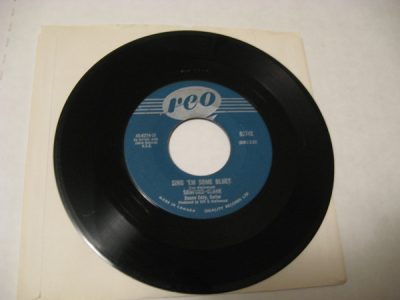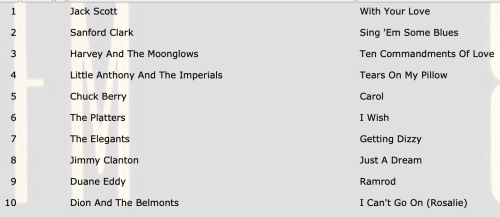#11: Sing ‘Em Some Blues by Sanford Clark
City: London, ON
Radio Station: CKSL
Peak Month: October 1958
Peak Position in London ~ #2
Peak position in Vancouver ~ did not chart
Peak Position on Billboard Hot 100 ~ did not chart
YouTube: “Sing ‘Em Some Blues”
Lyrics: N/A
Sanford Clark was born in Tulsa, Oklahoma in 1935. In his early childhood his family moved to Phoenix. Sanford got his first guitar when he was 12 years old. He played around Phoenix until 1953, then he was enlisted at the age of 18 into the U.S. Air Force for four years. He then moved to Johnston Island in the Pacific where he played music when he was off-duty. The Air Force assigned back home in Phoenix where returned to playing clubs again. Local guitar player, Al Casey, had been a friend of Sanford Clark’s since school days told local disc jockey Lee Hazlewood to go listen to Sanford. Hazlewood was impressed with Sanford’s voice. He was looking for somebody to record a song he had just written. About a week later he took Sanford into Floyd Ramsey’s studio with Al Casey and recorded “The Fool”. Hazlewood gave his wife, Naomi Ford, the songwriting credit for “The Fool.”
At the time it was not allowed for a producer or manager to also be a writer of the songs that were being recorded in the studio. Sanford stated that he felt they were a mix between Johnny Cash and Elvis Presley and just trying to get something a little different with there sound. People often wonder how the “drum sound” was made on the recording. They found a piece of split bamboo and beat it on the guitar case, then Casey insisted that the drummer use a drumstick.
Initially, nothing happened with the song. After the session, Sanford went back to the Air Force only for a short stay, he got an early discharge. Then he got a job delivering Canada Dry soft drinks around Phoenix. It was at that time that things started to happen with the record. Up to that point the record was on a local label MCI, and a disc jockey had sent the single to Randy Wood at Dot Records. It was at that point that Sanford signed with Dot. Dot re-released “The Fool” that summer, August “The Fool” climbed to #7 on the Billboard charts in the USA and #3 in Vancouver.
Following the song’s success, Clark opened on tour for Ray Price and Roy Orbison. Sanford Clark’s follow-up single written by Lee Hazelwood, “A Cheat”, peaked at #74 on the Billboard pop charts. Clark recalled later in an interview, “by the time it came out, Elvis so dominated the charts, it was hard for anyone to get a hit on to the charts. The deejay’s were getting requests for more and more Elvis.” Though that follow-up single didn’t chart in Vancouver, Clark’s third single release, “9 LB. Hammer” did, reaching #5 on the Canadian west coast.
Sanford Clark’s fourth single release was “Love Charms“, featuring Duane Eddy on guitar. The tune was not a hit in America, but it spent one brief week at #9 in Vancouver in June ’57. His next release was “Swanee River Rock”, reflecting a departure from his signature rockabilly sound. In November of 1957 he recorded “The Man Who Made An Angel Cry” a great Johnny Cash sound-a-like recording. He and Dot Records’ owner Randy Wood quarreled over the singer’s image.
After the eighth Dot single became another commercial flop, Sanford Clark signed to Jamie Records in 1958, continuing to work with Hazlewood. His first release with Jamie Records, “Still As The Night“, had a more familiar sound. It climbed into the Top 20 in Miami and Pittsburgh. Duane Eddy had played guitar on the single, though now with his instrumental tune, “Rabble Rouser”, Eddy began to go on tour. Sanford Clark’s longtime friend, Al Casey, joined Duane Eddy’s band.
In London, Ontario, DJs played the B-side to “Still As The Night”. This began to get generate listener requests to hear “Sing ‘Em Some Blues”.

“Sing ‘Em Some Blues” was written by Lee Hazelwood, who was born in rural Oklahoma in 1929. Hazlewood’s father was an oil worker and had a sideline as a dance promoter. He studied medicine at Southern Methodist University in Dallas, and served in the U.S. Army during the Korean War. He worked as a disc jockey in Coolidge, Arizona and in 1955 moved to KRUX radio in Phoenix. During that time, he was already writing songs and formed his own record label, Viv Records. Sanford Clark’s “The Fool” was the first Top Ten hit written by Lee Hazelwood. In 1958, “Rabble Rouser”, cowritten with Duane Eddy, was Hazelwood’s second big hit. He co-wrote numbers of subsequent hits for Eddy, including “Cannonball” and “Dance With the Guitar Man”. Hazelwood subsequently wrote “These Boots Are Made For Walkin'”, a number-one hit for Nancy Sinatra. As well, Nancy Sinatra had hits with Hazelwood’s songs “Sugar Town”, “Summer Wine”, “Jackson”, “Love Eyes”, “Some Velvet Morning”, and “How Does That Grab You Darlin’?” Lee Hazelwood also wrote “Houston” which was a hit for Dean Martin. Lee Hazelwood died in 2007 at age 78.
“Sing ‘Em Some Blues” peaked at #2 in London (ON), and charted in Seattle, Spokane (WA), and Vancouver (BC).
Clark continued to release singles, including “Modern Romance” and a cover of the 1954 #1 R&B hit by Johnny Ace, “Pledging My Love”. However, Clark was having no more success with Jamie Records then with Dot. When Sanford left Jamie Records he did one single for the 3-Trey label and another for the tiny Project Records. Neither record met with any success. Sanford became friendly with local sideman and struggling songwriter named Roger Miller. Roger asked Sanford to record a song called “Dang Me”. However, Sanford Clark declined. Roger Miller decided to record it himself and it launched Miller as one of the biggest Country-pop singers of the 1960’s. Sanford tried again, this time at Warner Brothers Records in 1964 and 1965. He nearly had a hit with the Lee Hazlewood composition “Houston“. Sanford recorded it, but Hazlewood produced another version of the same song with Dean Martin. Sanford said his version was doing fine, until they released Dean Martin’s version. Then radio stations dropped Clark’s version, preferring to spin Dean Martin’s disc. After two more unsuccessful contracts with Warner Brothers Records and then LHI Records, Sanford Clark quit recording in the late 60’s, after releasing 21 singles and several albums.
By the 1970’s Sanford Clark was only playing music on occasion. He made his living by labour and skill. One was construction, a trade he had pursued on and off since the 1950s. As a skilled blackjack player, Sanford Clark has made his other sideline gambling. With both talents he has made himself a comfortable living. In 2021, Sanford Clark died at the age of 85.
March 24, 2025
Ray McGinnis
References:
Sanford Clark bio, Rockabilly Hall of Fame.
Ed Masley, “How Phoenix Rocker Sanford Clark Shaped Keith Richards,” The Republic, September 8, 2015.
Garth Cartwright, “Lee Hazelwood Obituary,” Guardian, August 6, 2007.

CKSL 1410-AM London (ON) Top Ten | October 12, 1958

Not a bad tune. Too bad it didn’t make it nationally.